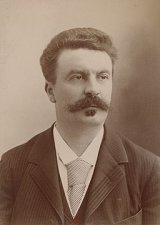The Model
"The Model" is a short story by Guy de Maupassant that explores themes of beauty, desire, and the complexities of human relationships. The narrative follows a struggling artist who becomes infatuated with a young woman he paints, ultimately revealing the tensions between artistic idealization and the realities of love and life. Maupassant delves into the nature of inspiration and the often fleeting nature of beauty, offering a poignant commentary on the sacrifices made in the pursuit of art and the emotional tumult that can ensue.
Curving like a crescent moon, the little town of Etretat, with its white cliffs, its white, shingly beach and its blue sea, lay in the sunlight at high noon one July day. At either extremity of this crescent its two “gates,” the smaller to the right, the larger one at the left, stretched forth—one a dwarf and the other a colossal limb—into the water, and the bell tower, almost as tall as the cliff, wide below, narrowing at the top, raised its pointed summit to the sky. On the sands beside the water a crowd was seated watching the bathers. On the terrace of, the Casino another crowd, seated or walking, displayed beneath the brilliant sky a perfect flower patch of bright costumes, with red and blue parasols embroidered with large flowers in silk. On the walk at the end of the terrace, other persons, the restful, quiet ones, were walking slowly, far from the dressy throng. A young man, well known and celebrated as a painter, Jean Sumner, was walking with a dejected air beside a wheeled chair in which sat a young woman, his wife. A manservant was gently pushing the chair, and the crippled woman was gazing sadly at the brightness of the sky, the gladness of the day, and the happiness of others. They did not speak. They did not look at each other. “Let us stop a while,” said the young woman. They stopped, and the painter sat down on a camp stool that the servant handed him. Those who were passing behind the silent and motionless couple looked at them compassionately. A whole legend of devotion was attached to them. He had married her in spite of her infirmity, touched by her affection for him, it was said. Not far from there, two young men were chatting, seated on a bench and looking out into the horizon. “No, it is not true; I tell you that I am well acquainted with Jean Sumner.” “But then, why did he marry her? For she was a cripple when she married, was she not?” “Just so. He married her—he married her—just as every one marries, parbleu! because he was an idiot!” “But why?” “But why—but why, my friend? There is no why. People do stupid things just because they do stupid things. And, besides, you know very well that painters make a specialty of foolish marriages. They almost always marry models, former sweethearts, in fact, women of doubtful reputation, frequently. Why do they do this? Who can say? One would suppose that constant association with the general run of models would disgust them forever with that class of women. Not at all. After having posed them they marry them. Read that little book, so true, so cruel and so beautiful, by Alphonse Daudet: 'Artists' Wives.' “In the case of the couple you see over there the accident occurred in a special and terrible manner. The little woman played a frightful comedy, or, rather, tragedy. She risked all to win all. Was she sincere? Did she love Jean? Shall we ever know? Who is able to determine precisely how much is put on and how much is real in the actions of a woman? They are always sincere in an eternal mobility of impressions. They are furious, criminal, devoted, admirable and base in obedience to intangible emotions. They tell lies incessantly without intention, without knowing or understanding why, and in spite of it all are absolutely frank in their feelings and sentiments, which they display by violent, unexpected, incomprehensible, foolish resolutions which overthrow our arguments, our customary poise and all our selfish plans. The unforeseenness and suddenness of their determinations will always render them undecipherable enigmas as far as we are concerned. We continually ask ourselves: “'Are they sincere? Are they pretending?' “But, my friend, they are sincere and insincere at one and the same time, because it is their nature to be extremists in both and to be neither one nor the other. “See the methods that even the best of them employ to get what they desire. They are complex and simple, these methods. So complex that we can never guess at them beforehand, and so simple that after having been victimized we cannot help being astonished and exclaiming: 'What! Did she make a fool of me so easily as that?' “And they always succeed, old man, especially when it is a question of getting married. “But this is Sumner's story: “The little woman was a model, of course. She posed for him. She was pretty, very stylish-looking, and had a divine figure, it seems. He fancied that he loved her with his whole soul. That is another strange thing. As soon as one likes a woman one sincerely believes that they could not get along without her for the rest of their life. One knows that one has felt the same way before and that disgust invariably succeeded gratification; that in order to pass one's existence side by side with another there must be not a brutal, physical passion which soon dies out, but a sympathy of soul, temperament and temper. One should know how to determine in the enchantment to which one is subjected whether it proceeds from the physical, from a certain sensuous intoxication, or from a deep spiritual charm. “Well, he believed himself in love; he made her no end of promises of fidelity, and was devoted to her. “She was really attractive, gifted with that fashionable flippancy that little Parisians so readily affect. She chattered, babbled, made foolish remarks that sounded witty from the manner in which they were uttered. She used graceful gesture's which were calculated to attract a painter's eye. When she raised her arms, when she bent over, when she got into a carriage, when she held out her hand to you, her gestures were perfect and appropriate. “For three months Jean never noticed that, in reality, she was like all other models. “He rented a little house for her for the summer at Andresy. “I was there one evening when for the first time doubts came into my friend's mind. “As it was a beautiful evening we thought we would take a stroll along the bank of the river. The moon poured a flood of light on the trembling water, scattering yellow gleams along its ripples in the currents and all along the course of the wide, slow river. “We strolled along the bank, a little enthused by that vague exaltation that these dreamy evenings produce in us. We would have liked to undertake some wonderful task, to love some unknown, deliciously poetic being. We felt ourselves vibrating with raptures, longings, strange aspirations. And we were silent, our beings pervaded by the serene and living coolness of the beautiful night, the coolness of the moonlight, which seemed to penetrate one's body, permeate it, soothe one's spirit, fill it with fragrance and steep it in happiness. “Suddenly Josephine (that is her name) uttered an exclamation: “'Oh, did you see the big fish that jumped, over there?' “He replied without looking, without thinking: “'Yes, dear.' “She was angry. “'No, you did not see it, for your back was turned.' “He smiled. “'Yes, that's true. It is so delightful that I am not thinking of anything.'
Translation
Translate and read this book in other languages:
Select another language:
- - Select -
- 简体中文 (Chinese - Simplified)
- 繁體中文 (Chinese - Traditional)
- Español (Spanish)
- Esperanto (Esperanto)
- 日本語 (Japanese)
- Português (Portuguese)
- Deutsch (German)
- العربية (Arabic)
- Français (French)
- Русский (Russian)
- ಕನ್ನಡ (Kannada)
- 한국어 (Korean)
- עברית (Hebrew)
- Gaeilge (Irish)
- Українська (Ukrainian)
- اردو (Urdu)
- Magyar (Hungarian)
- मानक हिन्दी (Hindi)
- Indonesia (Indonesian)
- Italiano (Italian)
- தமிழ் (Tamil)
- Türkçe (Turkish)
- తెలుగు (Telugu)
- ภาษาไทย (Thai)
- Tiếng Việt (Vietnamese)
- Čeština (Czech)
- Polski (Polish)
- Bahasa Indonesia (Indonesian)
- Românește (Romanian)
- Nederlands (Dutch)
- Ελληνικά (Greek)
- Latinum (Latin)
- Svenska (Swedish)
- Dansk (Danish)
- Suomi (Finnish)
- فارسی (Persian)
- ייִדיש (Yiddish)
- հայերեն (Armenian)
- Norsk (Norwegian)
- English (English)
Citation
Use the citation below to add this book to your bibliography:
Style:MLAChicagoAPA
"The Model Books." Literature.com. STANDS4 LLC, 2025. Web. 9 Mar. 2025. <https://www.literature.com/book/the_model_4092>.








Discuss this The Model book with the community:
Report Comment
We're doing our best to make sure our content is useful, accurate and safe.
If by any chance you spot an inappropriate comment while navigating through our website please use this form to let us know, and we'll take care of it shortly.
Attachment
You need to be logged in to favorite.
Log In